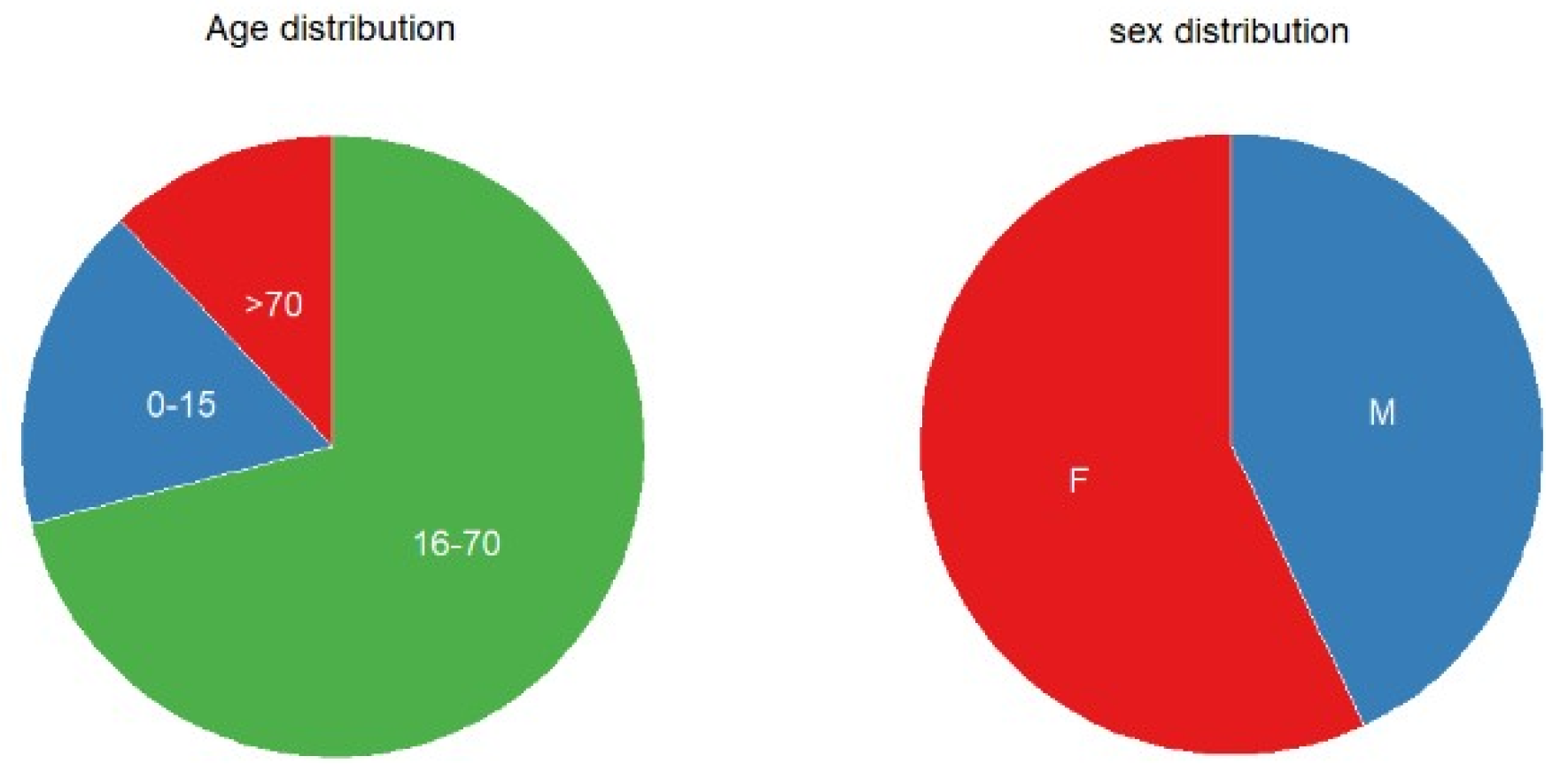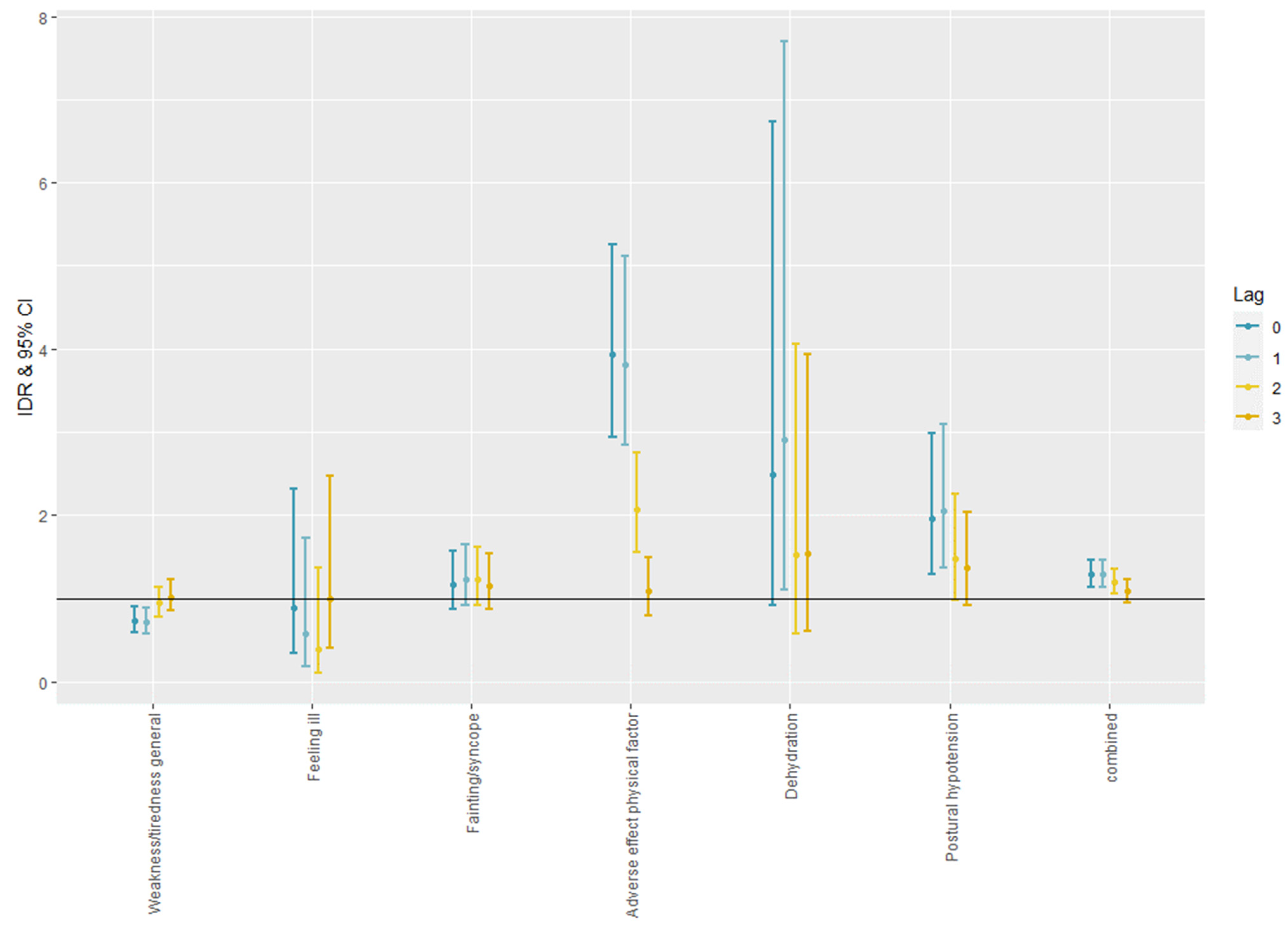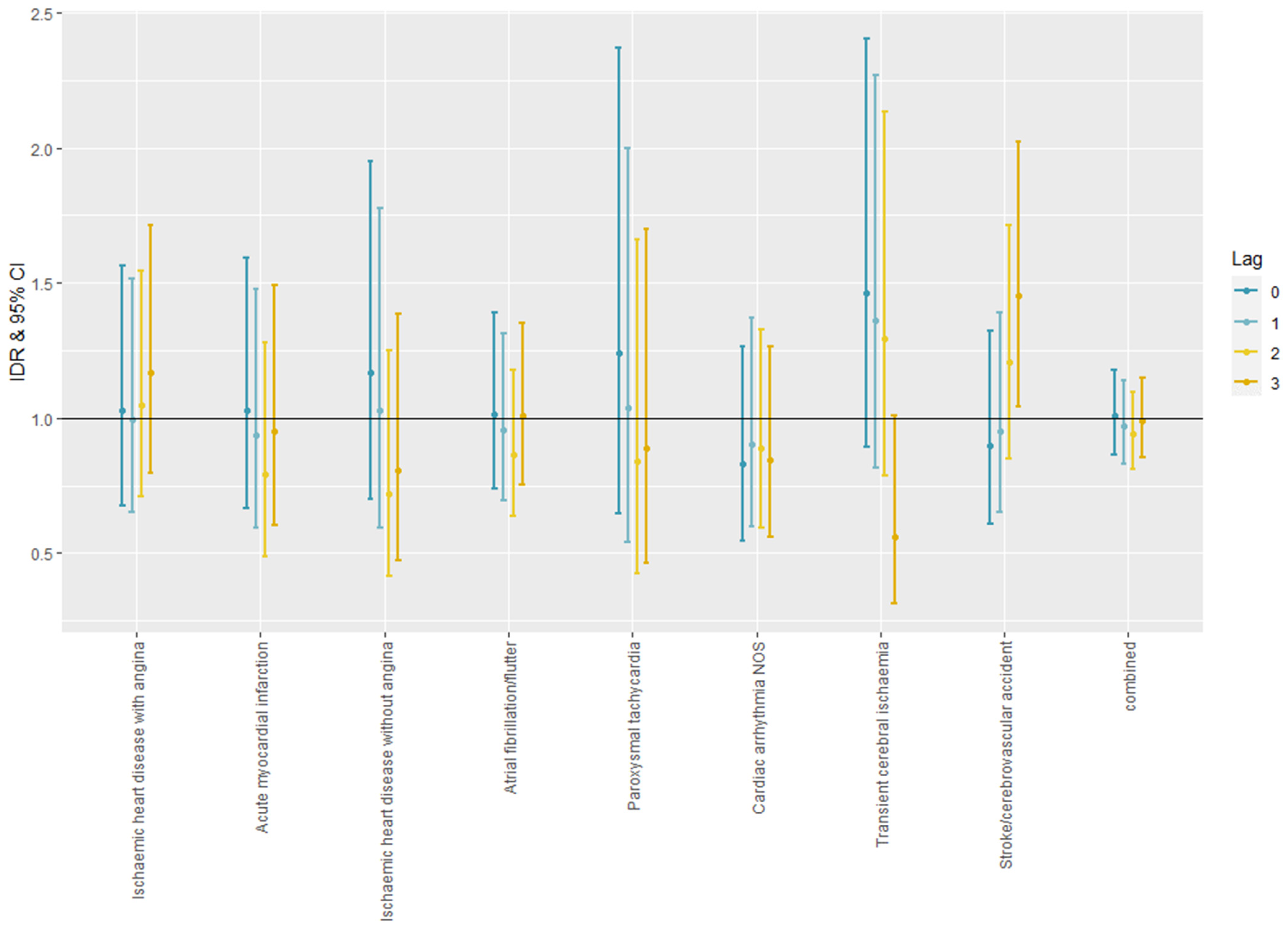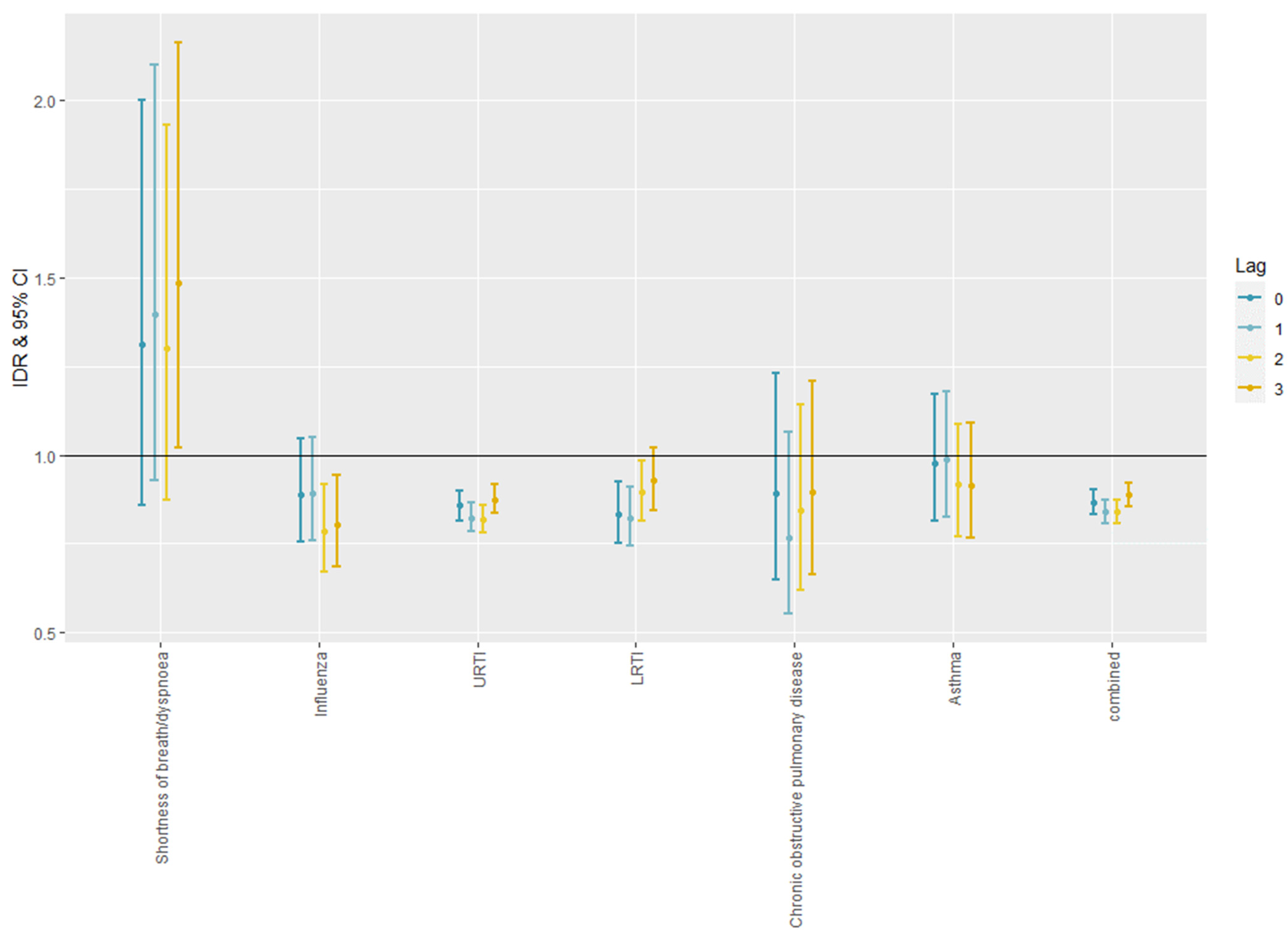The Effects of Heatwaves on Human Morbidity in Primary Care Settings: A Case-Crossover Study
Abstract
:1. Introduction
2. Materials and Methods
2.1. Study Design and Population
2.2. Data Collection
2.2.1. Outcome
2.2.2. Exposure
2.3. Data Analysis
3. Results
4. Discussion
5. Conclusions
Supplementary Materials
Author Contributions
Funding
Institutional Review Board Statement
Informed Consent Statement
Data Availability Statement
Acknowledgments
Conflicts of Interest
References
- Intergovernmental Panel on Climate Change. Climate Change 2014 Mitigation of Climate Change; Cambridge University Press: Cambridge, UK, 2014. [Google Scholar]
- Li, M.; Gu, S.; Bi, P.; Yang, J.; Liu, Q. Heat waves and morbidity: Current knowledge and further direction—A comprehensive literature review. Int. J. Environ. Res. Public Health 2015, 12, 5256–5283. [Google Scholar] [CrossRef] [Green Version]
- Turner, L.R.; Connell, D.; Tong, S. The Effect of Heat Waves on Ambulance Attendances in Brisbane, Australia. Prehospital Disaster Med. 2013, 28, 482–487. [Google Scholar] [CrossRef] [Green Version]
- Wang, X.Y.; Barnett, A.G.; Yu, W.; FitzGerald, G.; Tippett, V.; Aitken, P.; Neville, G.; McRae, D.; Verrall, K.; Tong, S. The impact of heatwaves on mortality and emergency hospital admissions from non-external causes in Brisbane, Australia. Occup. Environ. Med. 2011, 69, 163–169. [Google Scholar] [CrossRef] [Green Version]
- Schaffer, A.; Muscatello, D.; Broome, R.; Corbett, S.; Smith, W. Emergency department visits, ambulance calls, and mortality associated with an exceptional heat wave in Sydney, Australia, 2011: A time-series analysis. Environ. Health 2012, 11, 3. [Google Scholar] [CrossRef] [PubMed] [Green Version]
- Johnson, H.; Kovats, S.; McGregor, G.; Stedman, J.; Gibbs, M.; Walton, H.; Cook, L. The Impact of the 2003 Heat Wave on Mortality and Hospital Admissions in England. Epidemiology 2004, 15, S126. [Google Scholar] [CrossRef] [Green Version]
- Wang, X.-Y.; Barnett, A.; Guo, Y.-M.; Yu, W.-W.; Shen, X.-M.; Tong, S.-L. Increased risk of emergency hospital admissions for children with renal diseases during heatwaves in Brisbane, Australia. World J. Pediatrics 2014, 10, 330–335. [Google Scholar] [CrossRef] [PubMed]
- Knowlton, K.; Rotkin-Ellman, M.; King, G.; Margolis, H.G.; Smith, D.; Solomon, G.; Trent, R.; English, P. The 2006 California heat wave: Impacts on hospitalizations and emergency department visits. Environ. Health Perspect. 2009, 117, 61–67. [Google Scholar] [CrossRef]
- Williams, S.; Nitschke, M.; Weinstein, P.; Pisaniello, D.L.; Parton, K.A.; Bi, P. The impact of summer temperatures and heatwaves on mortality and morbidity in Perth, Australia 1994–2008. Environ. Int. 2012, 40, 33–38. [Google Scholar] [CrossRef]
- Kravchenko, J.; Abernethy, A.P.; Fawzy, M.; Lyerly, H.K. Minimization of Heatwave Morbidity and Mortality. Am. J. Prev. Med. 2013, 44, 274–282. [Google Scholar] [CrossRef]
- Wichmann, J.; Andersen, Z.J.; Ketzel, M.; Ellermann, T.; Loft, S. Apparent temperature and cause-specific mortality in Copenhagen, Denmark: A case-crossover analysis. Int. J. Environ. Res. Public Health 2011, 8, 3712–3727. [Google Scholar] [CrossRef] [Green Version]
- Smith, S.; Elliot, A.J.; Hajat, S.; Bone, A.; Smith, G.E.; Kovats, S. Estimating the burden of heat illness in England during the 2013 summer heatwave using syndromic surveillance. J. Epidemiol. Community Health 2016, 70, 459–465. [Google Scholar] [CrossRef] [PubMed] [Green Version]
- Smith, S.; Elliot, A.J.; Hajat, S.; Bone, A.; Bates, C.; Smith, G.E.; Kovats, S. The Impact of Heatwaves on Community Morbidity and Healthcare Usage: A Retrospective Observational Study Using Real-Time Syndromic Surveillance. Int. J. Environ. Res. Public Health 2016, 13, 132. [Google Scholar] [CrossRef] [PubMed] [Green Version]
- Vashishtha, D.; Sieber, W.; Hailey, B.; Guirguis, K.; Gershunov, A.; Al-Delaimy, W.K. Outpatient clinic visits during heat waves: Findings from a large family medicine clinical database. Fam. Pract. 2018, 35, 567–570. [Google Scholar] [CrossRef]
- Hajat, S.; Haines, A.; Sarran, C.; Sharma, A.; Bates, C.; Fleming, L.E. The effect of ambient temperature on type-2-diabetes: Case-crossover analysis of 4+ million GP consultations across England. Environ. Health 2017, 16, 73. [Google Scholar] [CrossRef] [PubMed] [Green Version]
- Maclure, M. The Case-Crossover Design: A Method for Studying Transient Effects on the Risk of Acute Events. Am. J. Epidemiol. 1991, 133, 144–153. [Google Scholar] [CrossRef] [PubMed]
- Mostofsky, E.; Coull, B.A.; Mittleman, M.A. Analysis of Observational Self-matched Data to Examine Acute Triggers of Outcome Events with Abrupt Onset. Epidemiology 2018, 29, 804–816. [Google Scholar] [CrossRef]
- Rothman, K.J. Epidemiology: An Introduction; Oxford University Press: Oxford, UK, 2012. [Google Scholar]
- Levy, D.; Lumley, T.; Sheppard, L.; Kaufman, J.; Checkoway, H. Referent Selection in Case-Crossover Analyses of Acute Health Effects of Air Pollution. Epidemiology 2001, 12, 186–192. [Google Scholar] [CrossRef]
- Truyers, C.; Goderis, G.; Dewitte, H.; vanden Akker, M.; Buntinx, F. The Intego database: Background, methods and basic results of a Flemish general practice-based continuous morbidity registration project. BMC Med. Inf. Decis. Mak. 2014, 14, 48. [Google Scholar] [CrossRef]
- Erpicum, M.; Nouri, M.; Demoulin, A. The Climate of Belgium and Luxembourg. In Landscapes and Landforms of Belgium and Luxembourg; Demoulin, A., Ed.; Springer International Publishing: Cham, Switzerland, 2018; pp. 35–41. [Google Scholar]
- Belgium RMI. What Does the RMI Do? Available online: https://www.meteo.be/en/about-rmi/introduction (accessed on 1 December 2021).
- Team RC. R: A Language and Environment for Statistical Computing; R Foundation for Statistical Computing: Vienna, Austria, 2021; Available online: https://www.R-project.org/ (accessed on 1 December 2021).
- Semenza, J. Excess hospital admissions during the July 1995 heat wave in Chicago. Am. J. Prev. Med. 1999, 16, 269–277. [Google Scholar] [CrossRef]
- Sheridan, S.C.; Lin, S. Assessing Variability in the Impacts of Heat on Health Outcomes in New York City Over Time, Season, and Heat-Wave Duration. EcoHealth 2014, 11, 512–525. [Google Scholar] [CrossRef]
- Nitschke, M.; Tucker, G.R.; Hansen, A.L.; Williams, S.; Zhang, Y.; Bi, P. Impact of two recent extreme heat episodes on morbidity and mortality in Adelaide, South Australia: A case-series analysis. Environ. Health 2011, 10, 42. [Google Scholar] [CrossRef] [Green Version]
- Chen, J.-h.; Jiang, H.; Wu, L.; Liao, X.; Lu, Y.; Tao, X.-Q.; Deng, P.-F.; Long, Y.; Huang, H.-l. Association of ischemic and hemorrhagic strokes hospital admission with extreme temperature in Nanchang, China—A case-crossover study. J. Clin. Neurosci. 2017, 43, 89–93. [Google Scholar] [CrossRef] [PubMed]
- Lavados, P.M.; Olavarría, V.V.; Hoffmeister, L. Ambient Temperature and Stroke Risk. Stroke 2018, 49, 255–261. [Google Scholar] [CrossRef]
- Ma, W.; Xu, X.; Peng, L.; Kan, H. Impact of extreme temperature on hospital admission in Shanghai, China. Sci. Total Environ. 2011, 409, 3634–3637. [Google Scholar] [CrossRef]
- Lowen, A.C.; Mubareka, S.; Steel, J.; Palese, P. Influenza virus transmission is dependent on relative humidity and temperature. PLoS Pathog. 2007, 3, 1470–1476. [Google Scholar] [CrossRef] [PubMed]
- Lowen, A.C.; Steel, J.; Mubareka, S.; Palese, P. High temperature (30 degrees C) blocks aerosol but not contact transmission of influenza virus. J. Virol. 2008, 82, 5650–5652. [Google Scholar] [CrossRef] [Green Version]
- Lowen, A.C.; Steel, J. Roles of humidity and temperature in shaping influenza seasonality. J. Virol. 2014, 88, 7692–7695. [Google Scholar] [CrossRef] [Green Version]
- Pica, N.; Bouvier, N.M. Ambient Temperature and Respiratory Virus Infection. Pediatric Infect. Dis. J. 2014, 33, 311–313. [Google Scholar] [CrossRef] [PubMed]
- Xu, Z.; Huang, C.; Hu, W.; Turner, L.R.; Su, H.; Tong, S. Extreme temperatures and emergency department admissions for childhood asthma in Brisbane, Australia. Occup. Environ. Med. 2013, 70, 730–735. [Google Scholar] [CrossRef]
- Wang, Y.-C.; Lin, Y.-K. Temperature effects on outpatient visits of respiratory diseases, asthma, and chronic airway obstruction in Taiwan. Int. J. Biometeorol. 2014, 59, 815–825. [Google Scholar] [CrossRef]
- Figgs, L.W. Emergency department asthma diagnosis risk associated with the 2012 heat wave and drought in Douglas County NE, USA. Heart Lung 2019, 48, 250–257. [Google Scholar] [CrossRef] [PubMed]
- Hansen, A.; Bi, P.; Nitschke, M.; Ryan, P.; Pisaniello, D.; Tucker, G. The effect of heat waves on mental health in a temperate Australian city. Environ. Health Perspect. 2008, 116, 1369–1375. [Google Scholar] [CrossRef] [PubMed] [Green Version]
- Ha, S.; Talbott, E.O.; Kan, H.; Prins, C.A.; Xu, X. The effects of heat stress and its effect modifiers on stroke hospitalizations in Allegheny County, Pennsylvania. Int. Arch. Occup. Environ. Health 2013, 87, 557–565. [Google Scholar] [CrossRef] [PubMed]
- Schwartz, J. Who is Sensitive to Extremes of Temperature? Epidemiology 2005, 16, 67–72. [Google Scholar] [CrossRef]
- Hansen, A.L.; Bi, P.; Ryan, P.; Nitschke, M.; Pisaniello, D.; Tucker, G. The effect of heat waves on hospital admissions for renal disease in a temperate city of Australia. Int. J. Epidemiol. 2008, 37, 1359–1365. [Google Scholar] [CrossRef] [Green Version]
- Hamdi, R.; Kusaka, H.; Doan, Q.-V.; Cai, P.; He, H.; Luo, G.; Kuang, W.; Caluwaerts, S.; Duchêne, F.; Van Schaeybroek, B.; et al. The State-of-the-Art of Urban Climate Change Modeling and Observations. Earth Syst. Environ. 2020, 4, 631–646. [Google Scholar] [CrossRef]
- Tong, S.; Wang, X.Y.; Barnett, A.G. Assessment of heat-related health impacts in Brisbane, Australia: Comparison of different heatwave definitions. PLoS ONE 2010, 5, e12155. [Google Scholar] [CrossRef] [Green Version]




| ICPCC | Diagnosis | ICPCC | Diagnosis |
|---|---|---|---|
| General and heat-related | Respiratory | ||
| A04 | Weakness/tiredness general | R02 | Shortness of breath/dyspnoea |
| A05 | Feeling ill | URTI (R74:77) | Upper respiratory infections |
| A06 | Fainting/syncope | LRTI (R78, R81) | Lower respiratory infections |
| A88 | Adverse effect physical factor | R80 | Influenza |
| T11 | Dehydration | R95 | Chronic obstructive pulmonary disease |
| K88 | Postural hypotension | R96 | Asthma |
| Cardiovascular | |||
| K74 | Ischaemic heart disease with angina | ||
| K75 | Acute myocardial infarction | ||
| K76 | Ischaemic heart disease without angina | ||
| K78 | Atrial fibrillation/flutter | ||
| K79 | Paroxysmal tachycardia | ||
| K80 | Cardiac arrhythmia NOS | ||
| K89 | Transient cerebral ischaemia (TIA) | ||
| K90 | Stroke/cerebrovascular accident | ||
| Start | End | Duration | Weight a | Intensity b | Highest Temp c |
|---|---|---|---|---|---|
| 1-August-2003 | 13-August-2003 | 13 | 52.38 | 4.03 | 33.8 |
| 18-June-2005 | 25-June-2005 | 8 | 29.97 | 3.75 | 32.9 |
| 9-June-2006 | 13-June-2006 | 5 | 13.71 | 2.74 | 31.3 |
| 15-July-2006 | 30-July-2006 | 16 | 68.03 | 4.25 | 36.2 |
| 7-July-2010 | 14-July-2010 | 8 | 24.61 | 3.08 | 33.2 |
| 21-July-2013 | 27-July-2013 | 7 | 24.61 | 3.52 | 32.4 |
| 30-June-2015 | 5-July-2015 | 6 | 28.47 | 4.74 | 34.5 |
Publisher’s Note: MDPI stays neutral with regard to jurisdictional claims in published maps and institutional affiliations. |
© 2022 by the authors. Licensee MDPI, Basel, Switzerland. This article is an open access article distributed under the terms and conditions of the Creative Commons Attribution (CC BY) license (https://creativecommons.org/licenses/by/4.0/).
Share and Cite
Alsaiqali, M.; De Troeyer, K.; Casas, L.; Hamdi, R.; Faes, C.; Van Pottelbergh, G. The Effects of Heatwaves on Human Morbidity in Primary Care Settings: A Case-Crossover Study. Int. J. Environ. Res. Public Health 2022, 19, 832. https://doi.org/10.3390/ijerph19020832
Alsaiqali M, De Troeyer K, Casas L, Hamdi R, Faes C, Van Pottelbergh G. The Effects of Heatwaves on Human Morbidity in Primary Care Settings: A Case-Crossover Study. International Journal of Environmental Research and Public Health. 2022; 19(2):832. https://doi.org/10.3390/ijerph19020832
Chicago/Turabian StyleAlsaiqali, Mahmoud, Katrien De Troeyer, Lidia Casas, Rafiq Hamdi, Christel Faes, and Gijs Van Pottelbergh. 2022. "The Effects of Heatwaves on Human Morbidity in Primary Care Settings: A Case-Crossover Study" International Journal of Environmental Research and Public Health 19, no. 2: 832. https://doi.org/10.3390/ijerph19020832
APA StyleAlsaiqali, M., De Troeyer, K., Casas, L., Hamdi, R., Faes, C., & Van Pottelbergh, G. (2022). The Effects of Heatwaves on Human Morbidity in Primary Care Settings: A Case-Crossover Study. International Journal of Environmental Research and Public Health, 19(2), 832. https://doi.org/10.3390/ijerph19020832







